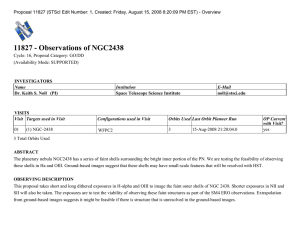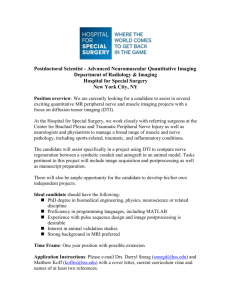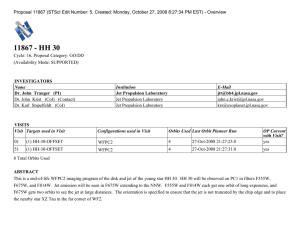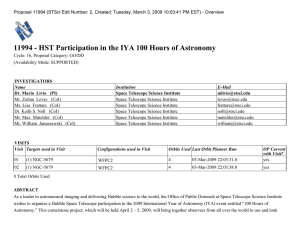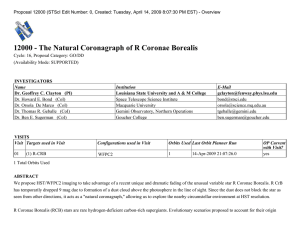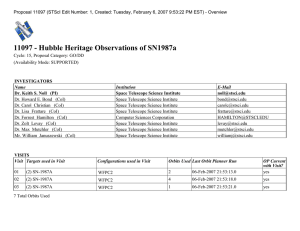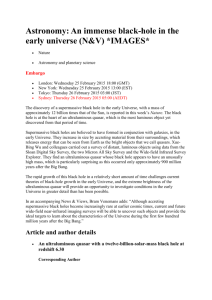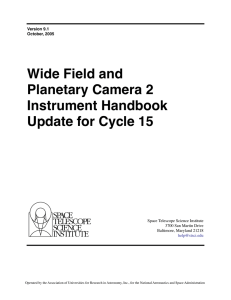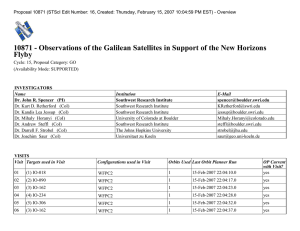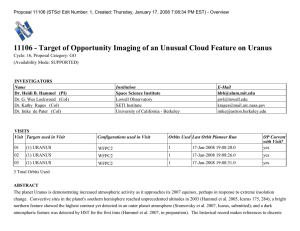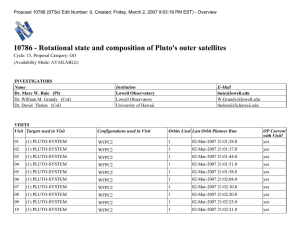11993 - High Resolution Imaging of a Binary Supermassive Black...
advertisement
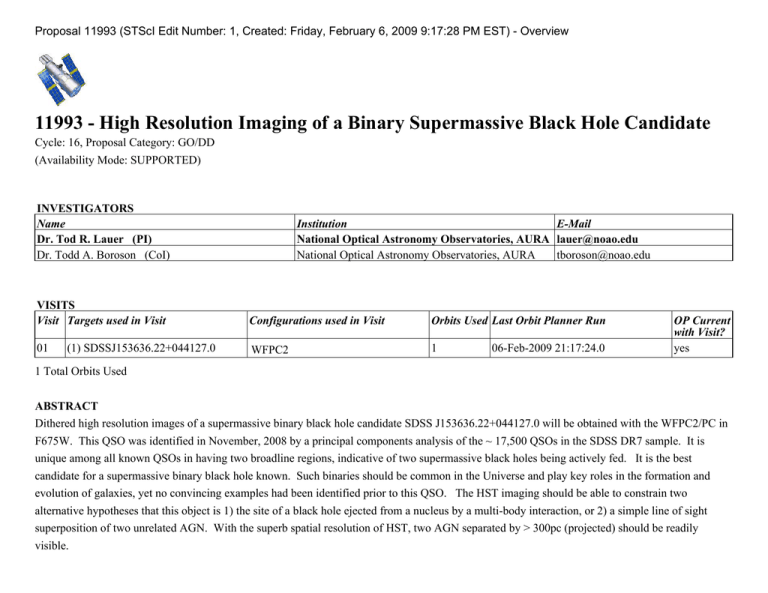
Proposal 11993 (STScI Edit Number: 1, Created: Friday, February 6, 2009 9:17:28 PM EST) - Overview 11993 - High Resolution Imaging of a Binary Supermassive Black Hole Candidate Cycle: 16, Proposal Category: GO/DD (Availability Mode: SUPPORTED) INVESTIGATORS Name Dr. Tod R. Lauer (PI) Dr. Todd A. Boroson (CoI) Institution E-Mail National Optical Astronomy Observatories, AURA lauer@noao.edu National Optical Astronomy Observatories, AURA tboroson@noao.edu VISITS Visit Targets used in Visit Configurations used in Visit Orbits Used Last Orbit Planner Run 01 WFPC2 1 (1) SDSSJ153636.22+044127.0 06-Feb-2009 21:17:24.0 OP Current with Visit? yes 1 Total Orbits Used ABSTRACT Dithered high resolution images of a supermassive binary black hole candidate SDSS J153636.22+044127.0 will be obtained with the WFPC2/PC in F675W. This QSO was identified in November, 2008 by a principal components analysis of the ~ 17,500 QSOs in the SDSS DR7 sample. It is unique among all known QSOs in having two broadline regions, indicative of two supermassive black holes being actively fed. It is the best candidate for a supermassive binary black hole known. Such binaries should be common in the Universe and play key roles in the formation and evolution of galaxies, yet no convincing examples had been identified prior to this QSO. The HST imaging should be able to constrain two alternative hypotheses that this object is 1) the site of a black hole ejected from a nucleus by a multi-body interaction, or 2) a simple line of sight superposition of two unrelated AGN. With the superb spatial resolution of HST, two AGN separated by > 300pc (projected) should be readily visible. Proposal 11993 (STScI Edit Number: 1, Created: Friday, February 6, 2009 9:17:28 PM EST) - Overview OBSERVING DESCRIPTION The observational goal is to test if the QSO is a pure point source. We will conduct F675W imaging in the PC1 CCD of WFPC2. The observations will be dithered in a 2X2 pattern of 0.5 pixel steps (with a CR-split at each position) to provide a Nyquist-sampled superimage. The final resolution should be ~0.06'' FWHM. The F675W bandpass covers H-beta for both redshift systems, as well as the [O III] lines of the r-system. With the leftover time in the orbit, we have added a single CR-split F439W exposure to add color information and to provide slightly better resolution. 2 Fixed Targets Patterns Visit Proposal 11993 - Visit 01 - High Resolution Imaging of a Binary Supermassive Black Hole Candidate Proposal 11993, Visit 01, implementation Diagnostic Status: No Diagnostics Scientific Instruments: WFPC2 Special Requirements: PCS MODE FINE # Primary Pattern Secondary Pattern (1) Pattern Type=WFPC2-BOX Coordinate Frame=POS-TARG Purpose=DITHER Pattern Orientation=26.56505 Number Of Points=4 Angle Between Sides=143.130102 Point Spacing=0.559017 Center Pattern=false Line Spacing=0.559017 # Name Target Coordinates Targ. Coord. Corrections (1) SDSSJ153636.22+04412 RA: 15 36 36.2200 (234.1509167d) 7.0 Dec: +04 41 27.30 (4.69092d) Equinox: J2000 Label Target Config,Mode,Aperture (1) SDSSJ153636.22 WFPC2, IMAGE, PC1 +044127.0 Spectral Els. F675W Opt. Params. ATD-GAIN=7; CR-SPLIT=0.5 Exposures # 1 2 (1) SDSSJ153636.22 WFPC2, IMAGE, PC1 +044127.0 F439W CR-SPLIT=0.5; ATD-GAIN=7 3 Sat Feb 07 02:17:28 GMT 2009 Exposures (1) Fluxes V=17.2+/-0.05 AB(675W)=16.73 Special Reqs. Groups Pattern 1-1 (1) Miscellaneous Reference Frame: ICRS Exp. Time/[Actual Dur.] 160 Secs [==>(Pattern 1, Split 1)] [==>(Pattern 1, Split 2)] [==>(Pattern 2, Split 1)] [==>(Pattern 2, Split 2)] [==>(Pattern 3, Split 1)] [==>(Pattern 3, Split 2)] [==>(Pattern 4, Split 1)] [==>(Pattern 4, Split 2)] 200 Secs [==>(Split 1)] [==>(Split 2)] Orbit [1] [1] Orbit Structure Proposal 11993 - Visit 01 - High Resolution Imaging of a Binary Supermassive Black Hole Candidate 4
